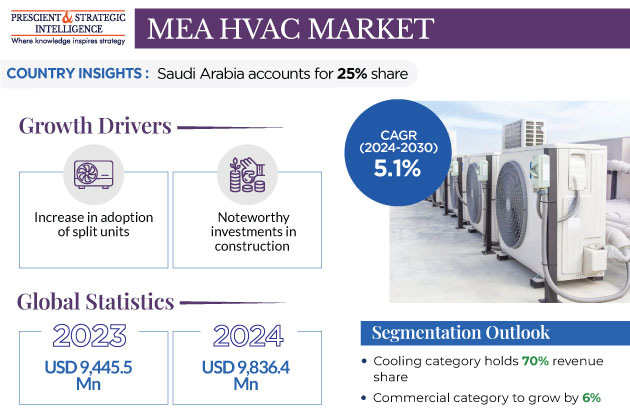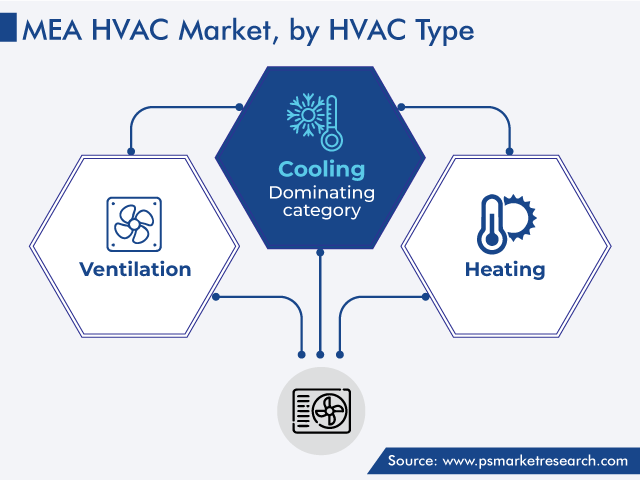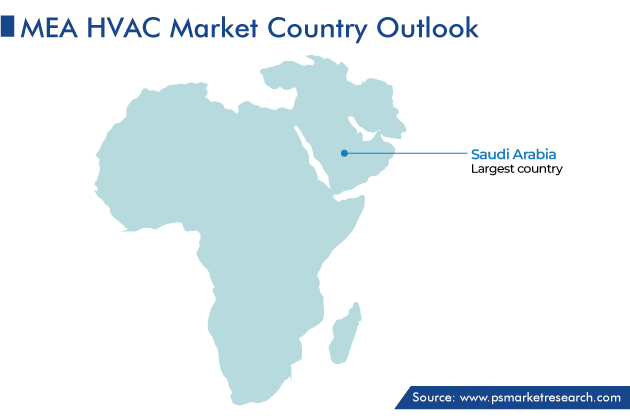Report Code: 11606 | Available Format: PDF | Pages: 210
Middle East and Africa HVAC Market by HVAC Type (Heating, Ventilation, Cooling), End User (Commercial, Industrial, Residential) - Industry Revenue Estimation and Demand Forecast To 2030
- Report Code: 11606
- Available Format: PDF
- Pages: 210
- Report Description
- Table of Contents
- Market Segmentation
- Request Free Sample
MEA HVAC Market Overview
The Middle East and Africa (MEA) HVAC market size stood at USD 9,445.5 million in 2023, and it is expected to reach USD 13,267.7 million by 2030, exhibiting a CAGR of 5.1% during the forecast period (2024–2030). This is due to an increase in the adoption of split units, due to their effortless attachments and towering energy efficient properties.

- With the note-worthy investment in the construction for commercial use, infrastructure, and government projects such as railway stations, airports, bus terminals, and education institutions, the demand for HVAC systems is increasing.
- Moreover, the rapid increase in the urbanized population, who have a higher standard of living, drives the market growth.
- Also, the installation of HVAC systems is gaining momentum, due to the rapid development of commercial sectors, such as movie theatres, malls, and office buildings.
- For instance, the government of Saudi Arabia entered into a project Baghdad, which is to be valued at USD 1,000 million. The International Airport is to be built and named after 'Jadat Baghdad' (Baghdad Avenue).
- Once it is completed, it will become the largest shopping mall in Iran and the development will encompass various amenities such as coffee shops, restaurants, and commercial business offices. Additionally, the project will include the construction of 4,000 apartments and 2,500 villas.
- Governments are aiming to boost their industrial sectors by creating a favorable business environment for foreign investors and supporting domestic firms.
- Additionally, a number of multinational corporations are relocating their manufacturing sites to MEA economies, which is projected to increase the constitution of industrial buildings.
- As a critical component of the construction process, the development of the HVAC market is on the rise. Thus, the growing construction sector will drive the demand for HVAC controls in the coming years.
- For instance, Danube Properties has initiated the Elitz 2 project in Dubai’s Jumeirah Village Circle (JVC), with a total value of USD 245 million.
- It is expected to be completed in the third quarter of 2026.
- 750 residential units will be offered by the Elitz 2 including 1-bedroom, 2-bedroom, and 3-bedroom apartments, and a few retail stores.
- The Elitz 2 will provide residents with an extensive array of amenities, including health and lifestyle facilities, a healthcare club, swimming pools, a sports arena, tennis courts, a barbecue area, jogging tracks, and various other community features.
In addition, the market is showing significant growth potential. This is because global players are establishing manufacturing centers in the region by forming partnerships with local manufacturers and expanding their distribution networks across various MEA countries.
Furthermore, factors driving this expansion include extreme weather conditions, population growth, infrastructure and urban development projects, and heightened healthcare concerns. These factors are also compelling both global and regional players to invest in the HVAC business in the MEA region.
The Middle East and Africa HVAC market is witnessing a growth in demand for VRF systems in high-rise buildings, owing to the flexibility and lower utility cost benefits it offers. With multiple tenants, an inefficiently designed HVAC system may result in poor air quality, and inconsistent airflow, resulting in high maintenance costs. VRF systems offer healthy air, personalized control, and installation flexibility, and eliminate the need for water piping. Additionally, it provides solutions to the complex installation of ducted split systems in high-rise buildings, where a single outdoor unit is deployed with multiple indoor units forming an efficient ductless multi-split system.
| Report Attribute | Details |
Market Size in 2023 |
USD 9,445.5 Million |
Market Size in 2024 |
USD 9,836.4 Million |
Revenue Forecast in 2030 |
USD 13,267.7 Million |
Growth Rate |
5.1% CAGR |
Historical Years |
2017-2023 |
Forecast Years |
2024-2030 |
Report Scope |
Market Trends, Drivers, and Restraints; Revenue Estimation and Forecast; Segmentation Analysis; Impact of COVID-19; Companies’ Strategic Developments; Market Share Analysis of Key Players; Company Profiling |
Segments Covered |
By HAVC Type; By End User; By Country |
Explore more about this report - Request free sample
HVAC Types Experiencing Significant Growth Potential
Based on HVAC type, the Middle East and Africa HVAC market has been categorized as heating, ventilation, and cooling, wherein the cooling category accounts for the largest revenue share. Moreover, ducted split/packaged contributed the largest market share in the cooling category.
In addition, the presence of numerous high-rise buildings in countries such as Saudi Arabia and the U.A.E. has been a major contributor to the large-scale adoption of ducted split/packaged units in the region.
Besides this, the efficient functioning of packaged units, where these are combined with ducts for controlled distribution of air, is one of the prime factors for their mass-scale adoption in manufacturing facilities and data centers/server rooms.

Commercial Sector Is Experiencing the Most Rapid Growth
Based on end user, the commercial category is dominating the Middle East and Africa HVAC market, and it is also expected to witness the fastest growth in the coming years.
- The growth of the market in this category is dependent on factors, such as increasing adoption of ventilation and air-cooling systems in various commercial spaces, including offices, malls, and retail shops.
- Furthermore, the substantial investment in the IT sector also resulted in a high level of HVAC system adoption within office spaces.
- During the forecasted period, there is an expected hike in the number of commercial buildings, which drives the market.
Saudi Arabia Is the Market Leader
Saudi Arabia dominates the MEA HVAC market, holding the largest revenue share of 25%. This is because the Saudi government has implemented energy efficiency regulations and shown a preference for environmentally friendly refrigerants, and green energy, which, in turn, drives the demand for HVAC systems that use eco-friendly refrigerants to enhance energy efficiency.
Moreover, the surging investment in green energy is also driving the market. For instance, ACWA Power is constructing a green hydrogen plant, which is evaluated at USD 8,400 million. The green hydrogen-based ammonia production facility will be built in the northwest region of Saudi Arabia, where NEOM is building an innovation hub and a smart city. The plant will be integrating with over 4 GW of renewable energy generated from solar and wind and will operate from 2025.

Some of the Key Players in the Market Are:
- Johnson Controls International PLC
- Ingersoll-Rand plc
- United Technologies Corporation
- Daikin Industries Ltd.
- Mitsubishi Electric
- Corporation
- Toshiba Carrier Corporation
- LG Electronics Inc.
- Fujitsu Limited
- Midea Group Co. Ltd
- Gree Electric Appliances Inc. of Zhuhai
- Danfoss A/S
Market Size Breakdown by Segment
The study uncovers the biggest trends and opportunities in the MEA HVAC market, along with offering segmentation analysis at the granular level for the period 2017 to 2030.
Based on HVAC Type
- Heating
- Furnaces
- Heat pumps
- Boilers
- Unitary heaters
- Ventilation
- Humidifiers/dehumidifiers
- Air cleaners
- Ventilation fans
- Air handling units and fan coil units
- Cooling
- Variable refrigerant flow
- Ducted split/packaged units
- Split units
- Chillers
- Room ACs
Based on End User
- Commercial
- Commercial offices/buildings
- Supermarkets/hypermarkets
- Government
- Healthcare
- Hospitality
- Transportation
- Others (including Education, Data Centers, Banking, Departmental Stores, and Convenience Stores)
- Industrial
- Oil and gas
- Food and beverage
- Automotive
- Energy and utilities
- Others (include Electronics, Textile, and Chemical and Cement)
- Residential
Region/Countries Reviewed for this Report
- Saudi Arabia
- U.A.E.
- Kuwait
- Qatar
- Nigeria
- South
- Egypt
- Oman and Bahrain
- Israel
- Rest of MEA HVAC Market
Want a report tailored exactly to your business strategy?
Request CustomizationWant an insight-rich discussion with the report author?
Speak to AnalystOur dedication to providing the most-accurate market information has earned us verification by Dun & Bradstreet (D&B). We strive for quality checking of the highest level to enable data-driven decision making for you
Our insights into the minutest levels of the markets, including the latest trends and competitive landscape, give you all the answers you need to take your business to new heights
With 24/7 research support, we ensure that the wheels of your business never stop turning. Don’t let time stand in your way. Get all your queries answered with a simple phone call or email, as and when required
We take a cautious approach to protecting your personal and confidential information. Trust is the strongest bond that connects us and our clients, and trust we build by complying with all international and domestic data protection and privacy laws